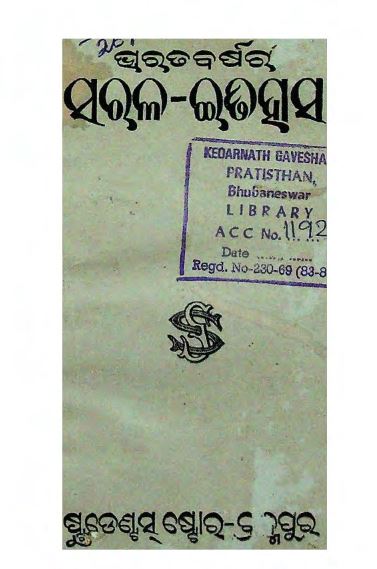Published in 1947, “Bharatabarsara Sarala Itihas” by Kedar Nath Mahapatra stands as a significant contribution to Odia literature and education, particularly in the realm of historical writing. This essay book not only serves as a textbook but also plays an integral role in the representation and understanding of the rich historical tapestry of India and specifically Odisha. In a period marked by political upheaval and cultural reawakening, Mahapatra’s work emerged as a beacon for educating future generations about their heritage and identity.
Kedar Nath Mahapatra, an eminent scholar and historian, aimed to present history in a manner that was both accessible and engaging for the Odia-speaking populace. “Bharatabarsara Sarala Itihas” is characterized by its simplicity and clarity of language, which enables readers from various backgrounds to comprehend the complexities of Indian history. Mahapatra’s narrative weaves together various threads of India’s past, making it applicable not just to scholars but also to ordinary readers, students, and those with a budding interest in history.
One of the remarkable aspects of this essay book is its focus on the chronological presentation of events. Mahapatra meticulously documents significant milestones in Indian history, beginning from ancient times, through the medieval period, and into the modern era. Each chapter is thoughtfully constructed to not only provide facts but also to interpret the socio-political context behind historical events. This approach encourages readers to think critically about the past and its implications for the present and future.
In addition to documenting events, Mahapatra incorporates cultural elements and the contributions of prominent figures who played pivotal roles in shaping Indian civilization. His emphasis on Odia culture and history is particularly noteworthy. By highlighting the achievements of Odia kings, poets, and artisans, he fosters a sense of pride and belonging among Odia readers. This cultural connection is vital, especially in the post-colonial context where regional identities were being redefined.
Moreover, “Bharatabarsara Sarala Itihas” transcends mere historical recounting. Mahapatra infuses his writing with a sense of narrative that captures the imagination. His style encourages readers to visualize historical events and understand the emotions and motivations of historical figures. This literary quality not only elevates the educational value of the book but also makes it a significant work of literature in its own right.
The timing of the publication in 1947 is also symbolic. It was the year India gained independence from British rule, a turning point in the nation’s history. At this juncture, Mahapatra’s work provides a context for readers to reflect on the sacrifices made by countless individuals for freedom and self-determination. In doing so, he instills a sense of duty and responsibility towards national unity and development among the youth.
In conclusion, “Bharatabarsara Sarala Itihas” by Kedar Nath Mahapatra is more than just a textbook; it is a treasure trove of knowledge that fosters a deep understanding of India’s history, especially within the context of Odisha. Its enduring relevance is a testament to Mahapatra’s vision of education as a means to empower individuals and communities. Through this narrative, he not only preserves the past but also inspires future generations to take pride in their heritage and actively participate in the storytelling of their culture.
Books Info
| Books name | Bharatabarsara Sarala Itihas |
| Author | Kedar Nath Mahapatra |
| No Of pages | 186 |
| Publisher | The Student’s Store |
| Publication | 1947 |
| Printed At | NA |
| Distributor | NA |

